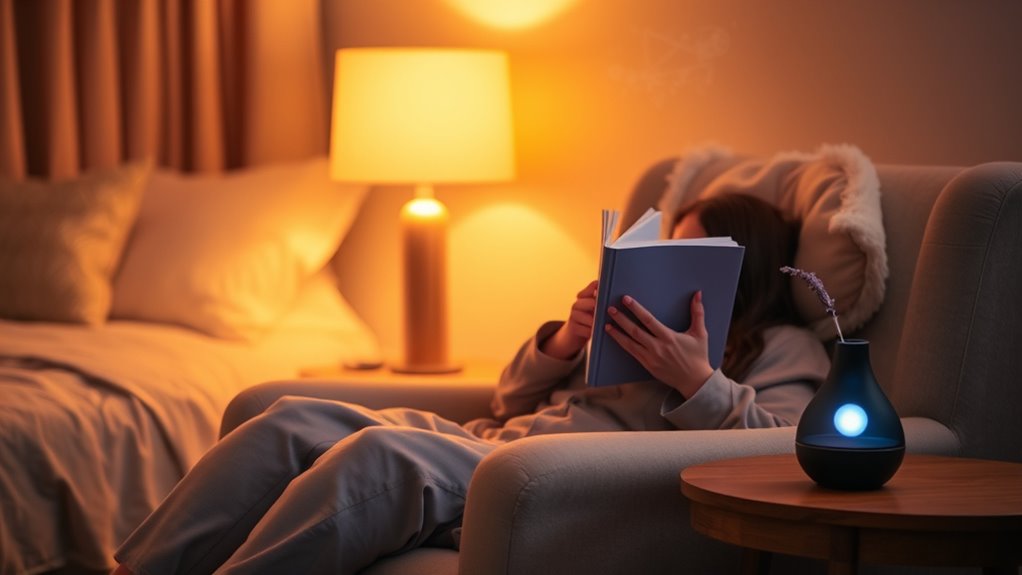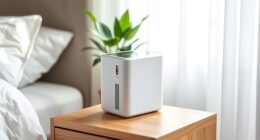To protect your sleep, turn off electronic devices at least 60 minutes before bed to reduce blue light exposure. Use blue light filtering software or wear glasses that block blue light in the evening. Dim or switch off bright lights, opting for red or orange nightlights, and create a dark, calm environment. Also, maintain a consistent sleep schedule and get plenty of natural daylight during the day. Keep exploring for more effective evening routines.
Key Takeaways
- Turn off screens at least 60 to 90 minutes before bedtime to reduce blue light exposure.
- Use blue light filtering software or built-in features like Night Shift during evening hours.
- Wear blue light blocking glasses 2-3 hours before sleep to preserve melatonin production.
- Dim or switch off bright, especially white or blue, indoor lighting in the hours before bed.
- Opt for red or orange nightlights to create a calming environment that supports natural sleep signals.
Turn Off Devices Before Bedtime
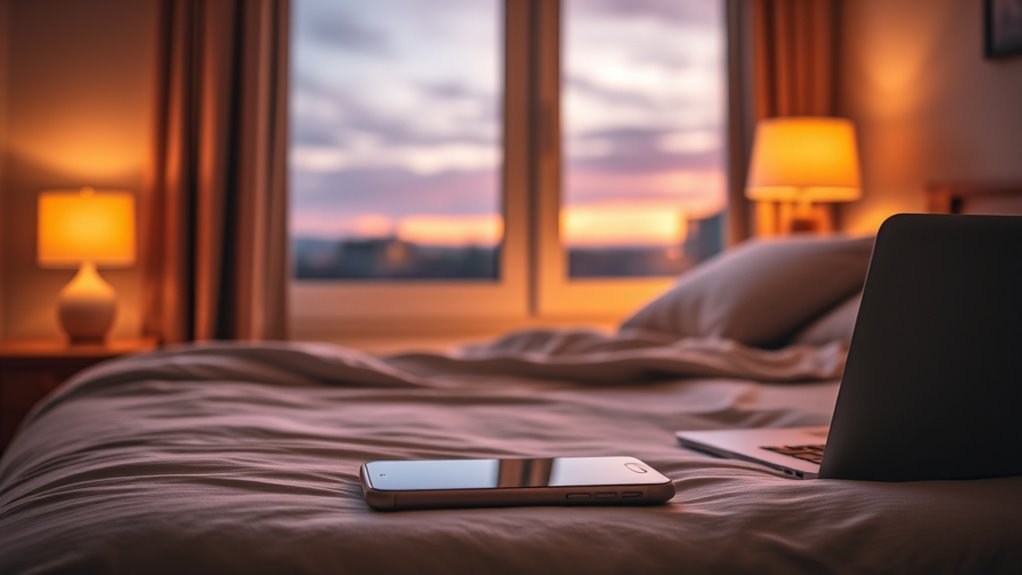
Turning off your devices at least 60 minutes before bed is one of the most effective ways to prepare your body for sleep. When you stop screen use early, your brain has time to wind down, helping you relax. Extending this break to 90 minutes or even two hours can improve sleep quality further. This habit allows melatonin, the sleep hormone, to rise naturally, making it easier to fall asleep quickly. Consistently shutting off devices creates a reliable sleep signal, reducing alertness and mental stimulation. Avoiding screens before bed also cuts down on electronic light exposure, which can delay sleep onset. Incorporating light exposure management and sleep-promoting habits into your routine can further enhance your rest and overall well-being. Limiting screen time can also prevent digital eye strain, contributing to better comfort and health.
Use Blue Light Filtering Software on Electronics

Using blue light filtering software on your electronics can help reduce blue light exposure during evening hours by shifting screen colors to warmer tones like yellow, orange, or red. These apps control video drivers directly to adjust color profiles, making screens less harsh for your eyes. However, they don’t block all blue light—especially from LED backlights—so some exposure remains. Color distortion from filters can cause eye strain or discomfort, which might offset benefits. While these apps may help lower screen brightness and reduce eye fatigue, evidence that they markedly improve sleep quality is limited. They’re convenient and easy to use but might impact battery life due to increased processing. For more thorough protection, consider combining software with physical filters or built-in device features like Night Shift. Additionally, understanding the limitations of blue light filters is important, as best vacuums for dust removal in 2024 emphasize the importance of overall indoor air quality for restful sleep. Moreover, advancements in AI-driven display technology are exploring ways to enhance visual comfort without compromising color accuracy. Incorporating blue light exposure research can help users make more informed choices about their evening screen time, especially as automation in technology continues to evolve and influence device design. Regularly updating your software and utilizing screen brightness controls can further optimize your viewing experience and reduce eye strain.
Dim or Switch Off Bright Lighting in the Evening
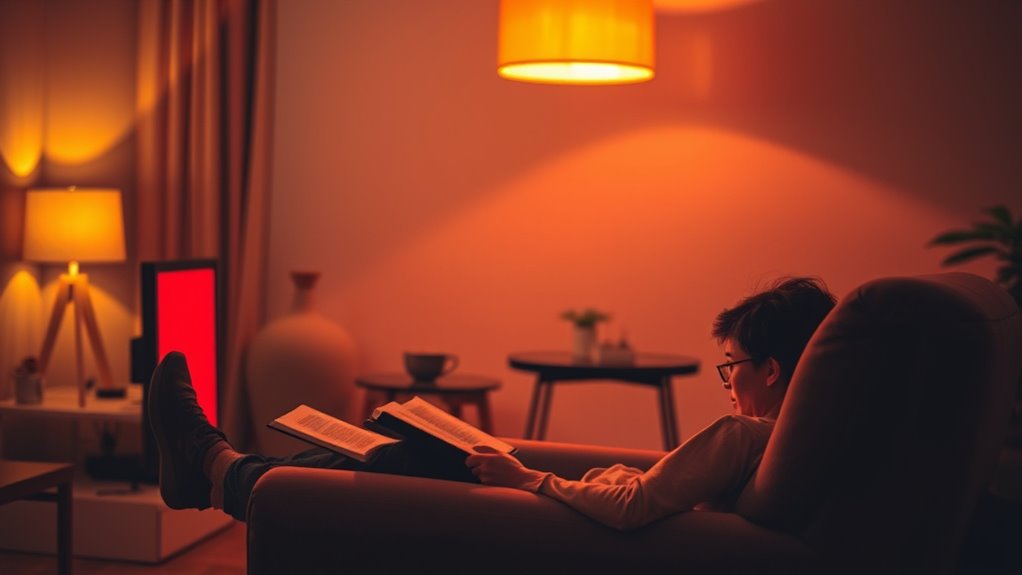
Reducing the brightness of your indoor lighting in the evening can substantially support your body’s natural sleep processes. Bright light exposure before bed suppresses melatonin, delaying sleep onset and disrupting your circadian rhythm. Even moderate lighting (~65 lux) can shift melatonin production later, making it harder to fall asleep on time. To promote better sleep, dim your lights to around 3 lux at least four hours before bedtime. Switch off unnecessary overhead and task lighting, and use lamps with dimming features to gradually reduce light levels. Soft, warm-toned bulbs are preferable, as they minimize circadian disruption. Creating a dim environment in the evening helps reset your internal clock, enhances sleep quality, and supports alertness and wellbeing the following day. Being aware of the impact of light exposure on sleep can help you make more informed choices about your evening lighting. Additionally, modern smart lighting systems can automatically adjust brightness levels to support your circadian health. Incorporating these lighting adjustments can also reduce the risk of sleep disruption, leading to more restful nights and improved overall health. Moreover, studies have shown that consistent evening lighting routines can positively influence overall sleep patterns and health outcomes.
Opt for Red or Orange Nightlights

Choosing red or orange nightlights in your bedroom creates a calming environment that supports your body’s natural sleep signals. These warm hues emit wavelengths that don’t suppress melatonin, unlike blue or white light. Red light even stimulates melatonin production, helping regulate your sleep cycle. Orange light mimics sunset lighting, signaling your body to wind down and relax. Both colors reduce nighttime anxiety and stress, which often interfere with sleep quality. Using red or orange nightlights helps maintain your circadian rhythm by providing gentle cues aligned with natural sleep-wake patterns. Their longer wavelengths penetrate the eye differently, allowing melatonin synthesis while still offering enough visibility for safety. Incorporating light wavelength considerations can further optimize your sleep environment. Additionally, choosing lighting with biological impact in mind can enhance your overall sleep quality. Replacing harsh, cooler lights with red or orange options creates a peaceful, sleep-friendly atmosphere that encourages better rest. The subtle influence of these hues can also promote a sense of spiritual calm, fostering relaxation and mental clarity before sleep. Properly selected nightlight colors can also help reduce sleep disruptions caused by abrupt exposure to bright light during late hours. Recognizing the importance of light spectrum effects allows you to tailor your lighting choices for optimal health benefits.
Wear Blue Light Blocking Glasses in the Evening
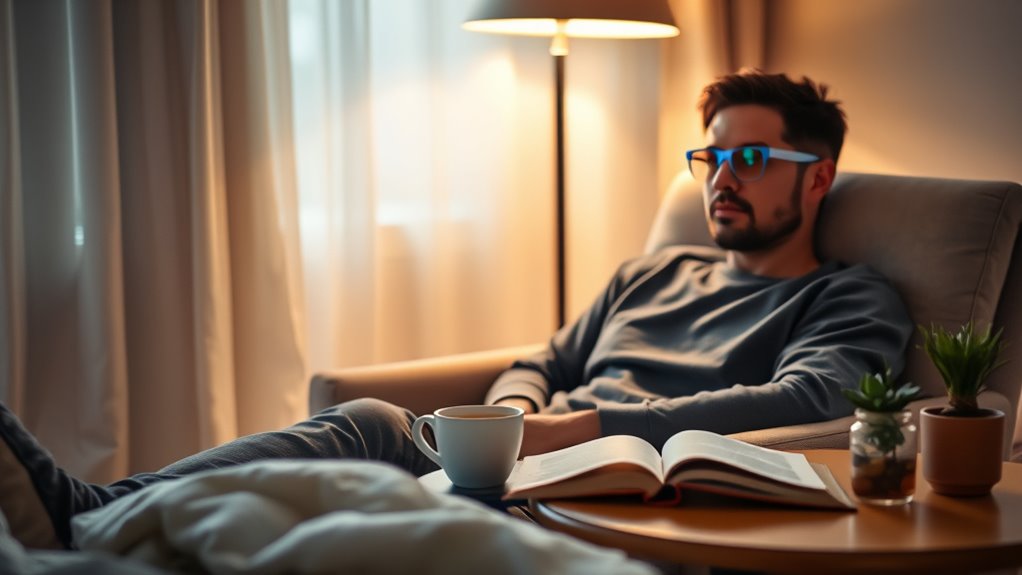
Wearing blue light blocking glasses in the evening can help protect your sleep cycle by minimizing exposure to light wavelengths that suppress melatonin. These glasses filter out blue and green light emitted by screens and artificial lighting, which can interfere with your body’s sleep signals. For best results, put them on at least 2-3 hours before bed, and wear them consistently after sunset. This practice helps restore melatonin production, making it easier to fall asleep and stay asleep. While some studies show benefits mainly for those with sleep issues or circadian disruptions, others suggest they can support healthy sleepers too. Choose glasses with tinted lenses that block up to 550nm for ideal melatonin preservation. Incorporating light management strategies can further enhance your sleep quality and overall health. Using blue light filtering devices and apps can complement the glasses for a more comprehensive approach. Combining this with other sleep hygiene habits maximizes your chances of a restful, restorative night. AI research indicates that minimizing light exposure in the evening can be particularly effective for maintaining healthy sleep patterns. Additionally, choosing quality blue light blocking glasses with proper tinting can significantly improve their effectiveness. Furthermore, recent cybersecurity vulnerabilities associated with digital devices highlight the importance of managing screen time and light exposure to protect overall well-being.
Create a Dark and Calm Sleep Environment
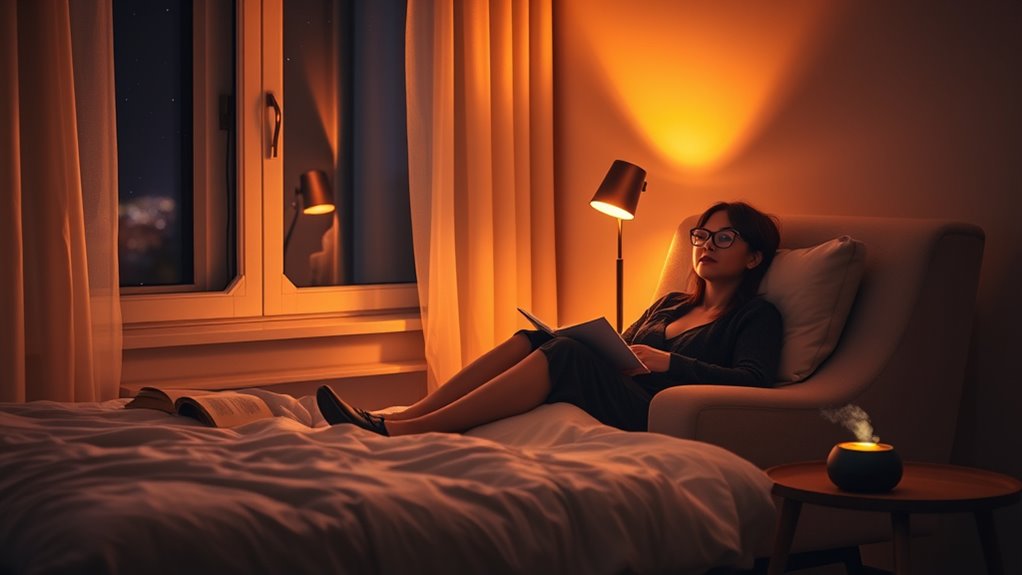
Creating a dark and calm sleep environment is essential for supporting your body’s natural sleep processes. Darkness triggers your pineal gland to produce melatonin, which promotes sleepiness and regulates your sleep-wake cycle. Even minimal light exposure can inhibit melatonin, making it harder to fall and stay asleep. To optimize darkness, use blackout curtains or shades to block streetlights and headlights, and consider wearing an eye mask for complete light blocking. Remove or cover electronic devices like alarm clocks, chargers, and nightlights that emit light. Ensure door gaps and window edges are sealed with draft stoppers or light strips. If you need lighting before bed, choose dim, warm-colored lights instead of blue or white ones. Using professional-grade lighting equipment can further minimize unwanted light exposure during evening routines. Additionally, using headphones to listen to calming sounds or guided meditations can help create a more peaceful environment. Incorporating light-blocking window films can provide an extra barrier against ambient light from outside. A dark, calm environment supports better sleep, mood, and overall health.
Maximize Daytime Natural Light Exposure
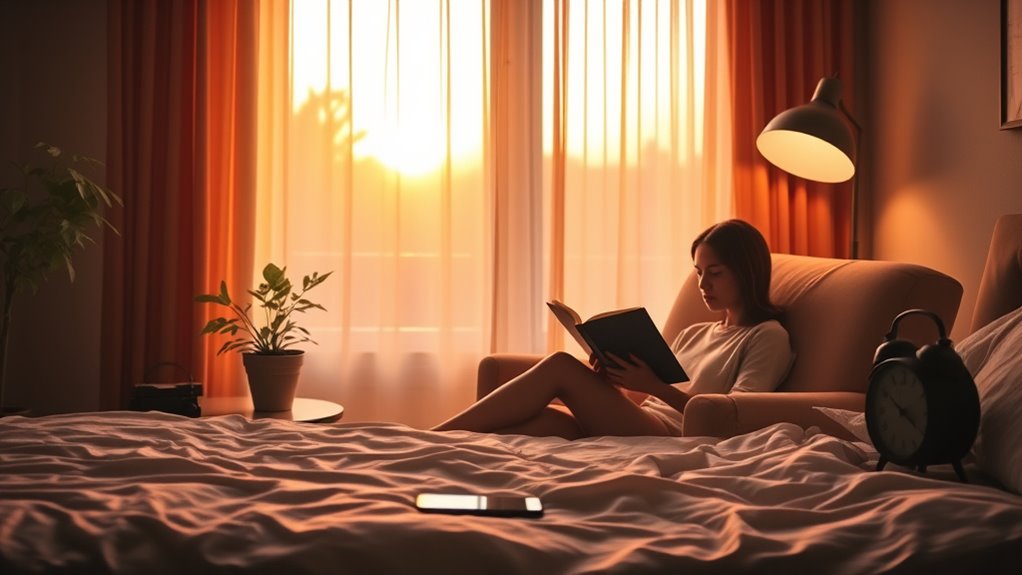
Maximizing your daytime natural light exposure is essential for maintaining a healthy circadian rhythm and improving overall sleep quality. When you spend time outside in natural light, especially in the morning, it helps advance your circadian clock, making it easier to fall asleep at night. Daylight also suppresses melatonin during the day, keeping you alert and focused, and allows melatonin to rise naturally in the evening to promote sleep. Without enough natural light, your circadian rhythm can become disrupted, leading to poor sleep and higher insomnia risk. To support your health, aim to get outside for at least 2 hours daily. This boosts vitamin D production, enhances mood, and strengthens your body’s internal clock, all of which contribute to better sleep and overall well-being.
Maintain a Consistent Sleep Routine
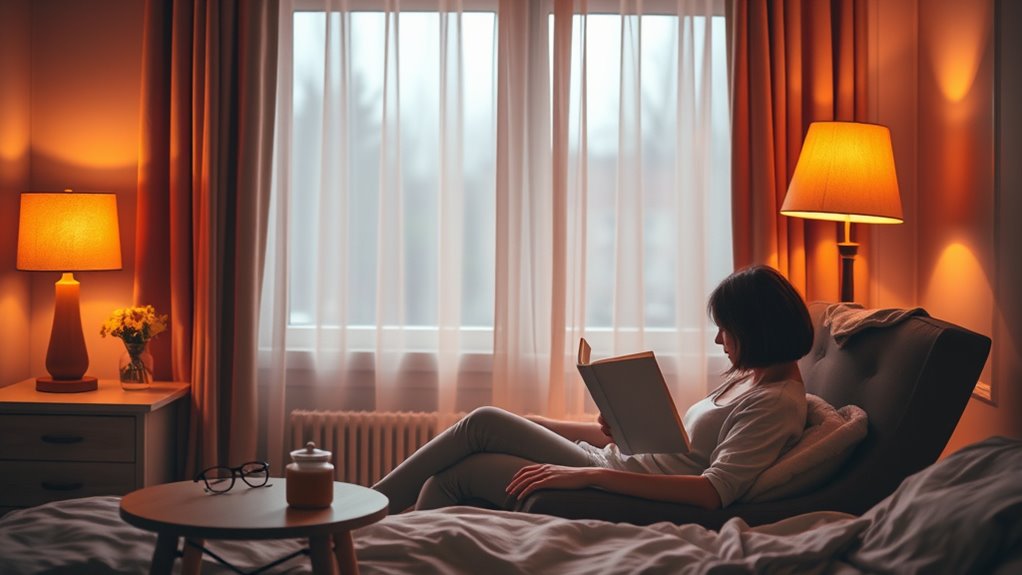
Maintaining a consistent sleep routine is essential for supporting your overall health and ensuring restorative sleep. When you go to bed and wake up at the same times daily, you lower your risk of mortality by up to 30%, including reductions in heart disease and cancer risks. Regular sleep schedules help manage stress, strengthen your immune system, and protect your metabolic health. They also improve mood, emotional control, and cognitive performance. To establish consistency, prioritize fixed wake times over varying sleep durations, use bedtime alarms, and aim for a 30-minute window for sleep timing. Gradually adjust your schedule by no more than 15 minutes daily. Consistent routines stabilize your circadian rhythm, enhance sleep quality, and reduce night-to-night variability, promoting overall well-being.
Frequently Asked Questions
How Effective Are Blue Light Blocking Glasses for Improving Sleep Quality?
You’re wondering how effective blue light blocking glasses are for improving sleep quality. While some studies suggest they can help, especially for people with insomnia or circadian rhythm issues, the results are mixed. Timing and individual conditions matter, and not all glasses block the same wavelengths. So, if you want to try them, use them in the evening, but don’t expect guaranteed improvements—research still isn’t conclusive.
Can Using Red Nightlights Fully Prevent Blue Light’s Impact on Melatonin?
You wonder if red nightlights can fully prevent blue light’s impact on melatonin. While red lights are less likely to disrupt melatonin production, they might not eliminate all effects entirely. Using red nightlights reduces blue light exposure, helping maintain your circadian rhythm. However, complete prevention depends on minimizing all sources of blue light. Combining red nightlights with other strategies, like limiting screen time, offers the best protection for your sleep.
Are There Specific Times to Start Reducing Blue Light Exposure Before Bed?
Imagine you’re in the 1800s, waiting for the sun to set—timing still matters. You should start reducing blue light exposure at least two to three hours before bed. This allows your melatonin to rise naturally, helping you fall asleep faster and enjoy better quality sleep. Use apps, dim your lights, or wear blue-blocking glasses during this window to protect your circadian rhythm and health.
Do All Electronic Devices Emit the Same Amount of Blue Light?
Not all electronic devices emit the same amount of blue light. Devices like smartphones and tablets, held close and used extensively, emit higher blue light levels in the 445-455 nm range. Computers and laptops also emit significant blue light, especially at similar wavelengths. Meanwhile, TVs and gaming consoles tend to produce varied emissions depending on their screen technology. You should be aware of these differences and use features like night mode to reduce exposure.
How Do Blue Light Filters Affect the Color Accuracy of Screens?
Blue light filters change how your screen looks by shifting colors toward warmer tones, often making whites appear yellowish or amber. This adjustment reduces blue light exposure but also impacts color accuracy, which can be problematic for tasks like photo editing or design. While advanced filters target specific blue wavelengths to preserve color fidelity, most filters still cause some color shifts, so you’ll notice a warmer, less true-to-life display.
Conclusion
By turning off your devices early, dimming lights, and wearing blue light glasses, you create a peaceful evening routine. Remarkably, those who stick to a consistent sleep schedule often find natural light exposure during the day enhances their rest. It’s no coincidence that these small changes can lead to better sleep. When you prioritize a calm, dark environment, you might just discover that restful nights become your new normal—making every morning a fresh start.
